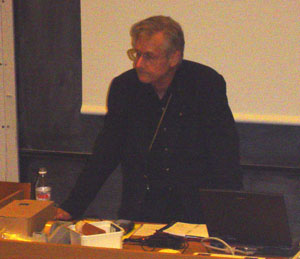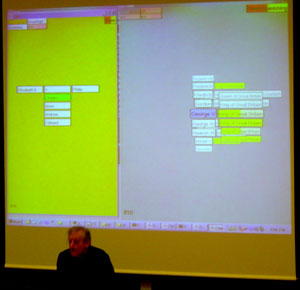 Ted NelsonAfter all of this, the first keynote of this conference will be delivered by hypertext veteran Ted Nelson. He basically begins by saying the present computer world is appalling - it is based on techie misunderstandings of human life and human thought, hidden behind flash user interfaces. The GUI (or for him PUI - park user interface) presents a cosmology which categorises all computer tasks into paper-based tasks. WYSIWYG, too, remains paper-based, of course - what you see is what you get when you print it out. (Developed, of course, by Xerox - what a surprise.)
Ted NelsonAfter all of this, the first keynote of this conference will be delivered by hypertext veteran Ted Nelson. He basically begins by saying the present computer world is appalling - it is based on techie misunderstandings of human life and human thought, hidden behind flash user interfaces. The GUI (or for him PUI - park user interface) presents a cosmology which categorises all computer tasks into paper-based tasks. WYSIWYG, too, remains paper-based, of course - what you see is what you get when you print it out. (Developed, of course, by Xerox - what a surprise.)
For Ted, the computer is a philosophy machine. It deals with arbitrary constructs (numbers, images, etc.), represented in arbitrary organisations (lists, tables, graphs, etc.). The rival structures for computer representation have been an enormous issue with highly significant implications. We simulate paper, but we simulate it under glass which cannot directly be folded, annotated, etc. But the use of documents should be about editability, mutability, reusability, tweakability, not the freezing of content into fixed formats.
The potential freedoms of the computer are undermined by the metaphors it applies to the documents it deals with - the geeks have built the computer in their own image. An example of this is the idea that with XML everything has to be hierarchical, that in fact everything is hierarchical ('geek metaphysics'). He vehemently disagrees with this view, and declares himself 'the enemy of XML'.
 Ted NelsonRather, the question is 'what can the computer do that paper cannot'? This includes for example the ability to link automatically to the source of every quotation, and the idea of 'profuse' documents which can be zoomed into for additional detail (rather than the 'peekaboo' version of hypertext where only a small number of predetermined links are available). (He refers back to his original Xanadu sketches from 1967 which outlined the kind of hypertext he's discussing here.) Some technical problems here, but we're moving on now to 'the fabric of literature'.
Ted NelsonRather, the question is 'what can the computer do that paper cannot'? This includes for example the ability to link automatically to the source of every quotation, and the idea of 'profuse' documents which can be zoomed into for additional detail (rather than the 'peekaboo' version of hypertext where only a small number of predetermined links are available). (He refers back to his original Xanadu sketches from 1967 which outlined the kind of hypertext he's discussing here.) Some technical problems here, but we're moving on now to 'the fabric of literature'.
Ted points out the problem with the focus on hierarchical structures in the World Wide Web consortium. He compares the conflict between W3C and Microsoft (which focus on hierarchies and the paper-based paradigm) to the rival popes of the 14th century: agreeing on most everything except who should be in charge. What's really needed, instead, is to problematise the paradigm of hierarchies and paper itself, and find alternative cosmologies; otherwise the conflicts are only about how to flesh out the cosmologies.
 TransliteratureHe now moves to suggest his own alternative constructs. The warp of the fabric of literatures (and the Web is merely one form of literature) is documents; the woof are the connections amongst them (yes, these are fabric-making terms). He suggests a new idea of transliterature - a literature where all connections and content (that users can deal with) are visible and available. Everyone should be able to attach a comment on a Webpage, to create overlay links in profusion on any document.
TransliteratureHe now moves to suggest his own alternative constructs. The warp of the fabric of literatures (and the Web is merely one form of literature) is documents; the woof are the connections amongst them (yes, these are fabric-making terms). He suggests a new idea of transliterature - a literature where all connections and content (that users can deal with) are visible and available. Everyone should be able to attach a comment on a Webpage, to create overlay links in profusion on any document.
The DeepLit project will endeavour to achieve this - 'why can't you have all of your documents hanging in the room like flypaper and zoom in on them?' Why do documents need to be 'opened' and 'closed' (like files); instead, why can't they be zoomed in on or out of as the user's focus changes? In DeepLit, documents can hang in space, with permanent connections always being able to be created (and the development of such linkages over time can also be tracked). (By comparison, on the other hand, the Web reduces documents to being placed in pigeonholes where they may be found.)
He shows a preview of how such systems could work - e.g. the immediate connection from quotes to their original context. He also introduces the idea of transcopyright - the ability for copyrighted materials to be able to reused in large amounts (but in small pieces) if access to the original context is maintained for every portion, and if (where money is involved) each downloader buys the pieces individually.
Xanadu has always maintained that structure and content are separated, but today they are usually conflated - you can only retrieve the finished, edited product which combines original sources, while in a Xanadu transcopyright context the 'edit list' (the list of sources and instructions on how to put them together) could be made available independently, with the user's browser then pulling together these sources automatically and in a fully copyright-compatible way. This is a kind of overlay of interlinkages over existing sources, and of course multiple alternative overlays may exist here.
 Ted NelsonFinally, then, beyond the focus on document structures, what about the structure of computing itself? As an alternative to the current structures, he suggests Zigzag (or zz-structure). This is a reenvisaging of the way spreadsheets are conceptualised - moving towards multiple dimensions (rather than simply x and y) and enabling the unlimited extension of dimensions and insertion of content into these axes without breaking the overall data structure (by comparison, try inserting a new row or column into a complex traditional spreadsheet without breaking everything).
Ted NelsonFinally, then, beyond the focus on document structures, what about the structure of computing itself? As an alternative to the current structures, he suggests Zigzag (or zz-structure). This is a reenvisaging of the way spreadsheets are conceptualised - moving towards multiple dimensions (rather than simply x and y) and enabling the unlimited extension of dimensions and insertion of content into these axes without breaking the overall data structure (by comparison, try inserting a new row or column into a complex traditional spreadsheet without breaking everything).












